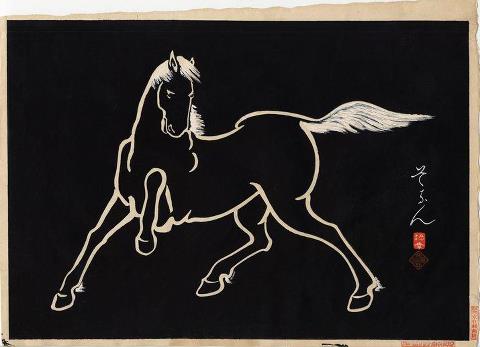187. The "Horse" Radical: 馬
The 10-stroke "horse" radical is quite straightforward in most respects.

"Horse" by Sonan Noda, 1952.
Japanese and English Names of the Radical
The 馬 radical is called "horse," of course, in English. It's うま in Japanese. That makes sense. It's just horse sense, you could say.
When the 馬 slides to the left of a character, we can use the more specific name うまへん, as in this example:
駒 (2010: horse; pony, colt; chessman)
Photo Credit: Eve Kushner
A blue horse in Verona, Italy. Ah, is this the origin of the expression "horse of a different color"?
Origins of the Horse Kanji
The "horse" radical, like the autonomous kanji 馬 (191: horse), is the pictograph of a horse, though this may be hard to see. Sears's early images don't make the matter any clearer.

Seal-script and LST seal–script versions of 馬.
All are © Richard Sears.
Kanji with a Clear Connection to Horses
Though the evolution of the shape is rather murky, the equine meaning of 馬 remains steadfast in several characters. For instance, we can clearly see a connection to horses in the definitions of these kanji:
騎 (1133: riding on horseback; equestrian; counter for equestrians)
駆 (1183: to run (race); rush; ride a horse; drive (a machine); gallop; drive (something) off)
The etymology of 騎 involves mounting a horse, whereas 駆 once depicted beating a horse to spur it on, says Henshall.
Stations for Horse
My husband is not a native English speaker. Of all the stupid things he ever saw in his English textbooks, "Where should I park the horse?" took the cake.
In Japan, the answer to that question could be "At the station":
駅 (233: station)
That is, 駅 once represented a "succession of horses," referring to "relay stations at which imperial messengers changed their horses," says Henshall. ("Changed their horses"? I imagine that they switched horses rather than freshening them up like changing diapers.) The meaning of 駅 later broadened to "station."
We also see the concept of "stationing" horses in this kanji:
駐 (1587: parking; residing in; stationed)
This character, says Henshall in his newer edition, originally meant “horse stands still,” later coming to mean “stop” or “stay” more broadly.
Photo Credit: Eve Kushner
On Shodoshima, an island in the Inland Sea, a sign marks the 山頂駅 (さんちょうえき), literally the "station at the peak of a mountain."

Photo Credit: Sui Feng
Throughout Japan, signs indicate where you shouldn't park (the car, not the horse):
駐車 (ちゅうしゃ: parking)
禁止 (きんし: forbidden)
Troubled Horses
Two more kanji are about troubled horses:
驚 (1172: surprise; to startle; astonish; frighten; wonder; amaze)
騒 (1530: clamor; noisy)
Originally, 驚 depicted a "startled horse," whereas 騒 represented "confusion caused by insect troubling horse." Both have broadened to have the meanings listed above. This information is again from Henshall. That is, it's coming to you straight from the horse's mouth.
Photo Credit: Eve Kushner
Part of a sculpture installation in Bologna, Italy, in July 2011.
Assorted Horses
We've covered all the Joyo kanji containing the "horse" radical, except for three that defy easy categorization:
験 (475: to test; attempt; examine; verify)
This kanji once had to do with "examining horses," says Henshall.
駄 (1541: good for nothing; clogs, sandals)
The part on the right used to be 大, giving us "big horse," which is to say "pack horse." This animal was not considered valuable, says Henshall, so 駄 also came to symbolize "poor quality" or "cheap." I'm not quite sure about the connection to footwear!
騰 (1660: rise)
Originally, says Henshall, this kanji represented a "leaping horse."
Photo Credit: Eve Kushner
At Rokko Farm, a dairy farm in the Rokko Mountains above Kobe, visitors can try their hand at making cheese, butter, ice cream, and the like. In part of a sign we find these words:
手作り (てづくり: handmade)
体験室 (たいけんしつ: workshop of personal experience)
